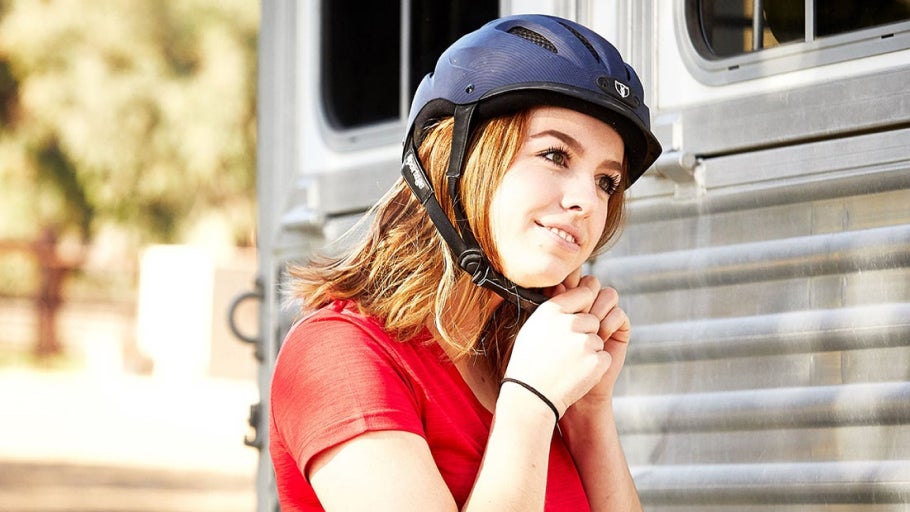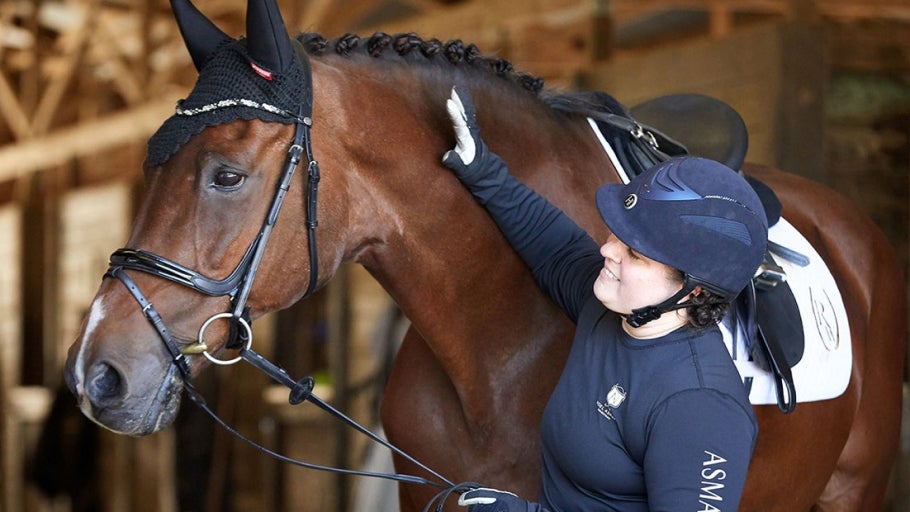
Equestrian Riding Helmet Safety Standards
No matter how long you have been riding, what your experience level is, or how trustworthy your horse is, a fall is possible any time you are on a horse's back. If you are committed to wearing a helmet during every ride, you have already made the most important safety step. But have you ever wondered how much protection your helmet provides? The University of Connecticut asked the same question and found that while 60% of horse-related deaths are caused by head injuries, helmets can reduce this risk by 70 to 80%.
Given the inherent risks with horseback riding and the importance of protecting your one-and-only noggin, a little research can be helpful in determining which helmet will be best for your needs and budget. Design, fit, and safety ratings vary from brand to brand, and even between styles. This makes it tricky to get the full story on helmet safety. Thankfully, there are established safety organizations that set guidelines for helmet testing and safety certifications.
With all this in mind, it is important to remember that the safest helmet is always the one that fits your head well. If you are unsure which helmet might be right for you, check out our favorite helmets as well as our helmet fitting guide! Read on to learn what level of helmet certification could best meet your needs.
Helmet Testing
Testing standards differ between organizations but generally include impact and retention tests. During impact testing, helmets are dropped from a specific height onto a metal object. The force transferred to the inside of the helmet upon impact is measured using a computer. It is then determined whether the helmet would protect the brain from major injury. The retention test pulls on the harness strap with a weighted device to ensure the helmet would stay in place during a fall.
Some standards may also include penetration and deformation tests. The penetration test drops a sharp, heavy spike onto the helmet shell. The deformation test simulates a crushing action by applying lateral pressure to either side of the helmet. Depending on the discipline you participate in and the level, these tests may be more or less crucial to your decision on which helmet to purchase. For example, riders who compete in higher-risk sports may decide that it is worth the investment to purchase a helmet with more stringent safety standards.
Equestrian Helmet Safety Ratings
Great: ASTM F1163
The American Society for Testing and Materials (ASTM) writes safety standards for many of the products that we come into contact with on a daily basis. Once those standards are in place, an independent testing laboratory called the Safety Equipment Institute (SEI) ensures that manufacturers design helmets that are up to par. An ASTM/SEI certified helmet is required by many equestrian associations, such as the United States Pony Club and the United States Equestrian Federation, and is mandatory when attending competitions held under these organizations.
The ASTM/SEI testing standard requires both impact and retention tests, as well as a visor test to make sure that the visor breaks away or flexes without injuring the face. Each of these tests is performed after the helmet is frozen to negative 20 degrees, heated to over 120 degrees, and submerged in water overnight. ASTM/SEI certification does not require a penetration or deformation test, which allows for some helmets sold in the United States to feature large ventilation holes.
Newer to the world of head protection are combination Hat Helmets, which mesh the function of a standard equestrian helmet with the form of your favorite cowboy hat - felt or straw! This allows riders who ride or compete in a discipline where helmets are less common to feel more confident and secure in their attire and safety decisions. Since these are sold and classified as helmets, they meet the same ASTM/SEI guidelines that all other helmets sold in the US are tested to.
| Key Features |
|
Note!
All helmets sold at Riding Warehouse meet the ASTM F1163 standard.
Better: VG1 01.040, PAS 015, & EN 1384:2017
These European standards are put together by a technical committee comprised of representatives from countries in the EU. In addition to impact, retention, and visor tests, these safety standards demand that helmets withstand penetration and crushing. Because of the inclusion of the latter two tests, these standards are thought to produce safer helmets than those only certified to ASTM standards by SEI.
Once a helmet is certified through one of the European standards, it receives a CE mark, meaning it is legal to sell in the EU with no further check-ins. Some manufacturers decide to voluntarily enroll in the Kitemark program, which sends their helmets through periodic audits with the British Standards Institute (BSI) to ensure their helmet production stays up to standard in the long run.
| Key Features |
|
Best: SNELL E2016
The Snell Foundation has developed what is thought to be the most demanding testing procedure for riding helmets. These tests include all aspects of the other certifications but with more stringent pass-and-fail standards. Snell drops the helmets from a greater height during the impact test onto a variety of differently-shaped anvils. This standard has the highest crush resistance rating as well. It also ensures the helmet offers sufficient head coverage, without sacrificing the rider's field of vision. There are currently only four helmet models in the world that are Snell certified.
| Key Features |
|
MIPS Technology Explained
Multi-Directional Impact Protection System, or MIPS, is an additional layer now being embedded in some helmets to reduce strain on the brain upon a fall. When the helmet makes contact with a surface, the low-friction MIPS layer allows the head to move 10 to 15 mm in all directions to dissipate the jarring impact on the brain. It is important to keep in mind that this technology does not replace coverage offered by other helmet safety measures but instead is meant to provide further protection. There are currently no safety standards that require MIPS as part of the Snell certification.
Helmet Replacement FAQ
When you purchase a helmet with any one of these safety certifications, you can rest assured it was built to protect your noggin. However, helmets have about a five-year lifespan, with or without a fall or impact history.
Do I need to replace my riding helmet after a fall?
The protective layer within riding helmets can be damaged in only one accident. You might not notice the damage just by looking at the helmet, so it is best to err on the side of caution after a fall or other significant impact. Some manufacturers offer a discount through a helmet crash replacement policy, so you can continue to keep your head safe without breaking the bank.
Do riding helmets expire? How often should you replace your helmet?
It is recommended to replace your helmet about every five years from the date it is first worn, even if it has never sustained damage from impact. This best practice will help ensure the valuable safety standards you paid for remain in prime working order, because you never want to take a chance on your safety.
How can I care for my helmet to give it the longest possible lifespan?
During storage, avoid exposing your helmet to high temperatures or direct sunlight; both can damage the important protective layer within your helmet that keeps you safe. This means no storing your helmet in a hot car! Keep your helmet clean with products made specifically for helmets, making sure to never get it too wet. Some helmets feature removable liners for easy washing and replacement.
Closing Thoughts
When shopping for your next riding helmet, it is important to look into each model's safety certifications to ensure you get the protection you need. Depending on the risk involved with the discipline you ride, you may prioritize safety in your helmet or be more concerned with comfort. Whether you need a lightweight, well-ventilated helmet for long days on the trail, or an ultra-safe skull cap for galloping around a cross-country track, we are sure to have an option that exceeds your expectations! As always, if you have any questions, feel free to contact our friendly customer service team at info@ridingwarehouse.com or by calling 1-800-620-9145. Have a happy (and safe) ride!
Related Articles:






